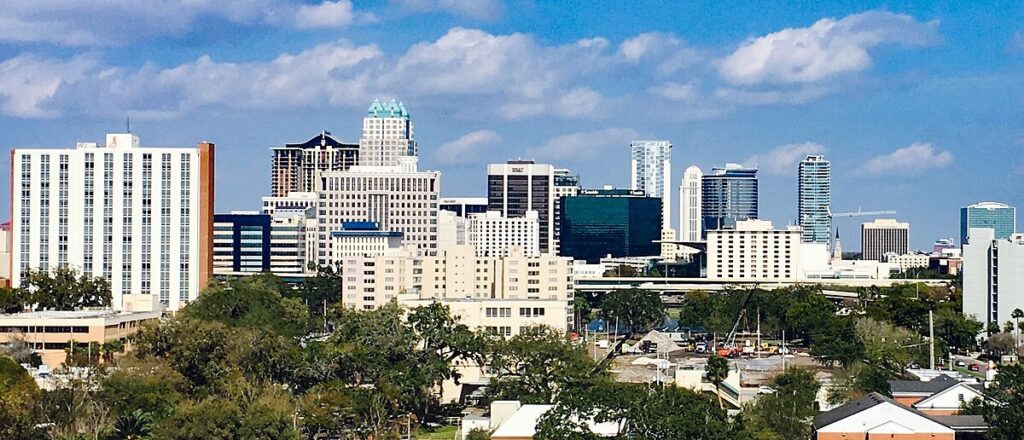
Moving to Orlando, Florida: A Comprehensive Relocation Guide
Considering moving to Orlando, Florida? This world-famous city offers theme park capital status, booming economy, and diverse opportunities. With approximately 320,000 residents in 2025 (metro 2.8 million+), Orlando combines tourism industry with technology growth and Central Florida’s dynamic metropolitan lifestyle.
Demographic Profile to Consider If Moving to Orlando:
Orlando’s 2025 population is approximately 320,000 within city limits, with the metro area exceeding 2.8 million residents. The median age is around 34 years, with young professionals, families, international residents, and tourism workers. The population is approximately 38% White, 38% Hispanic, 24% Black or African American. Orlando features diverse neighborhoods from downtown high-rises to College Park’s historic bungalows to Baldwin Park’s New Urbanism to suburban developments throughout. The city’s tourism industry, led by Walt Disney World, Universal Orlando, and SeaWorld, drives economic character. Orlando attracts diverse residents seeking employment opportunities, warm climate, and entertainment amenities. The community balances tourist economy with growing technology, healthcare, and professional sectors. Find trusted local services for moving, living, and working in Orlando.Orlando Relocation Directory
Cost of Living to Consider If Moving to Orlando:
Orlando offers moderate housing costs for a major metro. Median home values range from $350,000 to $480,000 in 2025, varying dramatically by neighborhood from modest areas to upscale communities. The median household income is approximately $58,000. Rental properties average $1,700 to $2,500 monthly. Florida’s absence of state income tax benefits residents. Overall cost of living is competitive for a major tourist destination, though housing costs have risen significantly with population growth. Orlando attracts diverse income levels from service workers to technology professionals. Housing costs vary from affordable neighborhoods to luxury developments. The combination of job opportunities and entertainment access drives demand.
Economy and Job Market:
Orlando’s economy is incredibly diverse, led by tourism but expanding into technology, healthcare, aerospace, and professional services. Major employers include Walt Disney World (largest single-site employer in U.S.), Universal Orlando, SeaWorld, AdventHealth, Orlando Health, Lockheed Martin, and numerous technology companies. The tourism industry employs over 100,000 directly. Lake Nona Medical City creates healthcare and research jobs. The University of Central Florida (second-largest U.S. university) graduates talent feeding local industries. Technology sector growth includes simulation, gaming, and digital media. Professional services, finance, and corporate offices thrive. Typical industries include hospitality, healthcare, aerospace, technology, and entertainment. The diverse economy provides opportunities at all skill levels.
Education:
Orange County Public Schools serves Orlando students, operating one of the nation’s largest districts with numerous schools throughout the city. School quality varies dramatically, with magnet programs and highly-rated schools alongside struggling facilities. The University of Central Florida in Orlando is America’s second-largest university offering comprehensive programs. Valencia College provides associate degrees and pathways to universities. Full Sail University specializes in entertainment and media. Rollins College offers prestigious liberal arts education. The concentration of universities creates an academic atmosphere. Educational quality requires research by families due to district size and variability.
Recreation and Lifestyle:
Orlando offers unparalleled theme park access with Walt Disney World, Universal Orlando (including The Wizarding World of Harry Potter), SeaWorld, and numerous other attractions. Residents enjoy annual pass benefits and local pricing. The city features extensive parks including Lake Eola Park downtown with swan boats and events. Professional sports include Orlando Magic (NBA), Orlando City SC (MLS), and Orlando Pride (NWSL). The Dr. Phillips Center for the Performing Arts presents world-class shows. Downtown Orlando offers nightlife, restaurants, and entertainment districts. The area’s numerous lakes provide boating and fishing. Atlantic beaches are 60 minutes east. The subtropical climate enables year-round outdoor activities. The lifestyle combines theme park access with metropolitan amenities, diverse dining, and entertainment options.
Healthcare and Services:
Orlando residents access world-class healthcare through AdventHealth (formerly Florida Hospital), Orlando Health, Nemours Children’s Hospital, and Orlando VA Medical Center. The Lake Nona Medical City includes University of Central Florida College of Medicine creating a healthcare innovation district. The region’s healthcare infrastructure is extensive with specialized care in all disciplines. The concentration of medical facilities ensures quality healthcare access.
Transportation:
Orlando benefits from Interstate 4, Florida’s Turnpike, State Road 408 (East-West Expressway), and State Road 417 (Central Florida GreeneWay). Orlando International Airport is a major hub with extensive domestic and international flights. LYNX operates comprehensive bus service throughout the metro. SunRail commuter train connects to suburbs. Traffic congestion is significant, particularly on I-4. Most residents use personal vehicles. Downtown and some neighborhoods offer walkability. Typical commute times range 30-50 minutes.
Conclusion:
Moving to Orlando in 2025 offers dynamic metropolitan living with theme park capital status, booming economy, and year-round entertainment. The city’s combination of tourism industry, technology growth, cultural diversity, and endless attractions makes it ideal for young professionals, families, and entertainment enthusiasts seeking Central Florida’s premier city with opportunity and excitement.

